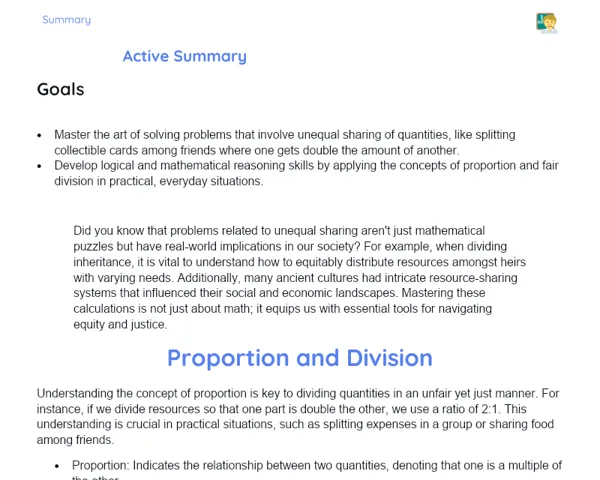Goals
1. Recognize the properties of addition and subtraction of decimal numbers.
2. Solve problems involving addition and subtraction of decimal numbers using various methods, including step-by-step calculations.
3. Enhance collaboration skills by working in groups to tackle mathematical challenges.
4. Foster critical thinking and analytical abilities through hands-on problem-solving.
Contextualization
The ability to add and subtract decimal numbers is a crucial skill we apply in our everyday lives, whether it's while shopping, measuring ingredients for a dish, or figuring out distances on a journey. For instance, when you buy snacks at the school canteen, you need to total the prices of items to know how much you owe and subtract the amount you've paid to ensure you get the right change. Mastering how to handle decimal numbers is vital for not only achieving good grades but also for managing daily situations and making wise choices.
Subject Relevance
To Remember!
Properties of Decimal Addition
The addition of decimal numbers adheres to the same rules as the addition of whole numbers: commutativity, associativity, and the presence of an identity element (zero). These principles are essential for performing accurate and efficient calculations, whether mentally or using written methods.
-
Commutativity: The order of the numbers does not affect the outcome of the addition. Example: 2.5 + 3.7 = 3.7 + 2.5.
-
Associativity: The grouping of numbers in addition does not alter the result. Example: (1.2 + 2.3) + 3.4 = 1.2 + (2.3 + 3.4).
-
Identity Element: Adding a decimal number to zero retains its value. Example: 4.5 + 0 = 4.5.
Properties of Decimal Subtraction
In contrast to addition, the subtraction of decimal numbers is neither commutative nor associative. Nevertheless, comprehending these properties is vital for accurately solving subtraction problems, especially those that involve more complex calculations.
-
Non-Commutativity: The sequence of the numbers affects the result of the subtraction. Example: 5.2 - 3.1 ≠ 3.1 - 5.2.
-
Non-Associativity: The grouping of numbers in subtraction influences the result. Example: (7.5 - 2.3) - 1.2 ≠ 7.5 - (2.3 - 1.2).
Mental Calculation Strategies
Cultivating mental calculation strategies is crucial for performing operations with decimal numbers swiftly and accurately. This includes breaking down numbers, rounding to make calculations easier, and applying operation properties.
-
Decomposition: Splitting numbers into smaller parts to simplify addition or subtraction. Example: 7.4 - 2.5 can be viewed as 7 - 2 and 0.4 - 0.5.
-
Rounding: Adjusting numbers to ease mental calculations and then correcting the final result. Example: 8.75 + 3.25 can be rounded to 9 + 3 = 12, and then adjusted to 12 - 0.25 = 11.75.
-
Use of Properties: Utilizing properties like commutativity in addition to rearrange numbers conveniently.
Practical Applications
-
Everyday Shopping: Calculating the total spent and determining change when shopping at darshinis or supermarkets.
-
Cooking: Accurately measuring ingredients while following a recipe that lists specific amounts.
-
Construction: Computing precise measurements of construction materials like concrete, wood, and other supplies.
Key Terms
-
Decimal Addition: A mathematical operation that adds two or more decimal numbers to obtain a total.
-
Decimal Subtraction: A mathematical operation that calculates the difference between two decimal numbers.
-
Commutativity: A property of addition where the order of the numbers does not impact the result.
-
Associativity: A property of addition that allows regrouping of numbers without affecting the outcome.
-
Identity Element: A number that, when added to another, remains unchanged (zero in addition).
Questions for Reflections
-
How can knowing how to add and subtract decimal numbers aid you in daily life?
-
In what ways do the principles of mathematical operations help solve more intricate problems?
-
In which careers do you think precision in calculating decimal numbers is most important? Why do you think so?
The Perfect Recipe Challenge
To solidify your understanding of adding and subtracting decimal numbers, create and compute a recipe using decimal quantities of ingredients.
Instructions
-
Select a simple recipe you enjoy and list the ingredients along with their respective quantities in decimal form. Example: 1.5 cups of flour, 0.75 cups of sugar, etc.
-
Calculate the total amount of ingredients needed for the recipe.
-
Imagine you only have half the amount required for one of the ingredients. Determine how much you would need to subtract from that ingredient to adjust the recipe.
-
Document the calculations you performed and verify if the results align.
-
Share your recipe and calculations with your classmates and discuss the strategies you employed.



